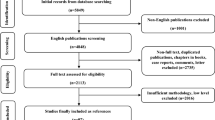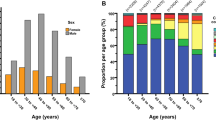Abstract
Objective: To evaluate staghorn calculi response to ESWL using simple radiological indicators which are stone size, stone homogeneity, and stone density. Patients and methods This is a prospective study of 60 patients with staghorn calculi where the majority had ESWL. The relationship between response and size, homogeneity and density is studied. Results Single staghorn calculus less than 4 cm, heterogeneous with stone density similar to bone or a little denser than bone has best response to ESWL.
Conclusion: ESWL is useful as first line therapy for staghorn calculi less than 4 cm, heterogeneous with similar density to bone or a little denser than bone.
Similar content being viewed by others
References
HN Whitfield (1988) ArticleTitleLithotripsy Br J Hosp Med 39 319–394
J Shah HN Whitfield (2002) ArticleTitleUrolithiasis through the ages BJU Int 89 801–810 Occurrence Handle11972501
M Lal M Hussain A Hashmi et al. (2000) ArticleTitleESWL monotherapy of renal calculi J Nephrol Urol Transplant 1 13–17
SAH Rizvi SAA Naqvi Z Hussain et al. (2002) ArticleTitleThe management of stone disease BJU Int 89 IssueIDSuppl 1 62–68 Occurrence Handle11876736
JS Wolf RV Clayman (1997) ArticleTitlePercutaneous nephrostolithotomy Urol clin N Am 24 43–58
JE Lingeman D Newman JHO Mertz et al. (1996) ArticleTitleExtracorporeal shock wave lithotripsy: the Methodist Indiana experience J Urol 135 1134–1137
JT Ehreth GW Drach ML Arnett et al. (1994) ArticleTitleExtracorporeal shock wave lithotripsy: multicenter study of kidney and upper ureter versus middle and lower ureter treatments J Urol 152 1379–85 Occurrence Handle1:STN:280:ByqD3MfmvFM%3D Occurrence Handle7933164
AS Cass (1995) ArticleTitleComparison of first generation (Dornier HM3) and second generation (Medstone STS) lithotriptors: treatment result with 13864 renal and ureteral calculi J urol 153 588–592 Occurrence Handle1:STN:280:ByqC28rkvFI%3D Occurrence Handle7861488
CG Chaussy GJ Fuchs (1987) ArticleTitleExtracorporeal shockwave lithotripsy Monogr Urol 4 80
P Mattelaer T Schroder N Fischer et al. (1994) ArticleTitleIn situ extracorporeal shock wave lithotripsy of distal ureteral stones parameters for therapeutic success Urol Int. 53 87–91 Occurrence Handle1:STN:280:ByqD1MbmsFc%3D Occurrence Handle7801423
Author information
Authors and Affiliations
Corresponding author
Rights and permissions
About this article
Cite this article
Murshidi, M.S. Simple Radiological Indicators for Staghorn Calculi Response to ESWL. Int Urol Nephrol 38, 69–73 (2006). https://doi.org/10.1007/s11255-005-3156-y
Issue Date:
DOI: https://doi.org/10.1007/s11255-005-3156-y




